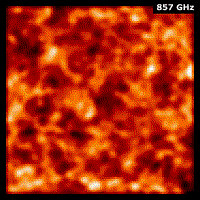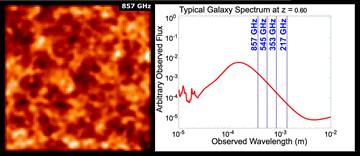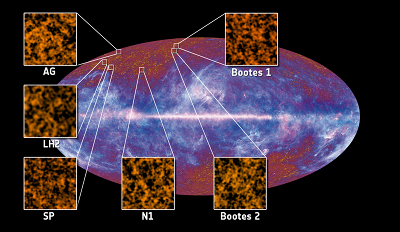Planck sees traces of early structure formation in the cosmic infrared background
11 January 2011
While targeting the Cosmic Microwave Background, Planck has also captured another important diffuse radiation, the Cosmic Infrared Background, which consists of the light emitted by all galaxies since their formation. This signal, detected by Planck at submillimetre wavelengths, exhibits a high degree of structure and enables astronomers to investigate the still unclear link between star-forming galaxies and the underlying distribution of dark matter, up to the earliest phases of the formation of cosmic structure. This result is amongst the highlights presented by the Planck Collaboration at a conference held from 10 to 14 January 2011 in Paris, France.
|
Animation showing the Cosmic Infrared Background fluctuations observed by Planck at various frequencies. Credit: ESA/Planck Collaboration |
The main goal of ESA's Planck mission is to map the Cosmic Microwave Background (CMB), the relic radiation of the Big Bang which pervades the entire Universe, and to pinpoint its tiny fluctuations with unprecedented accuracy. In the process, Planck is also sensitive to another, very intriguing background emission which peaks at a different wavelength range, namely the Cosmic Infrared Background (CIB). The CIB, which is about 50 times weaker than the CMB, consists of the cumulative infrared emission from all galaxies throughout cosmic history and, being produced by the dust within such galaxies, it carries a wealth of information about the processes of star formation therein.
Dusty, star-forming galaxies at high redshift are extremely difficult to detect individually because they are so faint and numerous that confusion among sources plagues observations substantially; in addition, the angular resolution achievable in the far-infrared and submillimetre portions of the electromagnetic spectrum—the rather long wavelengths where such objects emit the bulk of their radiation—is not particularly good. In this context, the CIB represents an exceptional tool to study these objects and to trace their overall distribution.
"Thanks to Planck's extensive spectral coverage, we have been able to detect the CIB signal and its fluctuations with great accuracy in the submillimetre range, down to frequencies where it has never been seen before," comments Jean-Loup Puget from the Institut d'Astrophysique Spatiale in Orsay, France, who is principal investigator of the High Frequency Instrument (HFI) on board Planck, the instrument used in this study. "The quality of the data collected by Planck thus far is so good that, at the highest available frequency, it is possible to spot the fluctuations even by eye," he adds.
The fluctuations detected in the CIB trace the large-scale distribution of star-forming galaxies and, to some extent, the underlying distribution of the dark matter halos in which galaxies are believed to reside. "These data allow us to investigate how the processes of star formation taking place in galaxies are related to the dark matter, which constitutes the scaffold where galaxies form and evolve," explains Guilaine Lagache, also from the Institut d'Astrophysique Spatiale, who led this study along with Olivier Doré from the Jet Propulsion Laboratory/Caltech in Pasadena, USA.
|
Animation showing the anisotropies in the Cosmic Infrared Background at different frequencies along with the typical spectra of galaxies at the redshifts to which each frequency channel is most sensitive. Credit: ESA/Planck Collaboration |
Moving across the various frequencies probed by Planck's HFI, the amount and extent of structure observed are rather different, as a consequence of the fact that each frequency channel is most sensitive to the emission coming from galaxies at a certain redshift (z). Observations at the highest frequency, corresponding to 857 GHz, yield most information about galaxies up to z~1, whereas the lower frequencies offer a chance to peer farther and farther away, out to z~1–4, thus emphasising Planck's ability to track down the early phases of galaxy formation.
"At the moment, we are still learning how to work with these outstanding data. Since the CIB signal is an integrated emission, to which virtually all galaxies contribute, we need to put a lot of effort into properly modelling the data in order to interpret them and extract the wealth of valuable information they contain about the history of cosmic structure," adds Lagache.
The models employed for the data analysis rely on the results of numerical simulations of structure formation as well as on observations of the distribution of galaxies on large scales. "Additional information about the cosmic large-scale structure will also be provided by Planck in the future through the study of secondary anisotropies in the CMB," comments Hervé Dole, also from the Institut d'Astrophysique Spatiale. Secondary anisotropies are those fluctuations imprinted on the CMB as the photons travel throughout the cosmic web—an example is the gravitational lensing of the CMB—and they naturally retain a memory about the large-scale distribution of matter in the Universe. "A combined study of both the CMB and CIB, which will be possible with future Planck data, stands out as a promising tool to explore in even greater detail the connection between dark and luminous matter in the Universe," notes Dole.
The detection of the CIB anisotropies is the result of an extensive work of analysing Planck data, which required the development of a number of new technical tools. "For this study, we developed a specific method to robustly test and quantify all sources of uncertainties that is inherited from techniques usually employed in the analysis of the CMB anisotropies," explains Nicolas Ponthieu from the Institut d'Astrophysique Spatiale. "This project focussing on the CIB is a great example of the cooperation between researchers studying galaxies and those interested in the CMB, since the methods and expertise have been shared between the two groups," adds Doré. This is a notable advantage of the large Planck Collaboration, allowing for a fruitful synergy between many astrophysical communities.
|
Location on the sky of the first six fields used to detect the Cosmic Infrared Background anisotropies. Credit: ESA/Planck Collaboration |
In order to perform these early measurements of the CIB, astronomers from the Planck Collaboration employed only about 2.5 per cent of the entire sky, focussing on a handful of fields located at high galactic latitude, where the foreground contamination due to the Milky Way's diffuse emission is less dramatic. The remarkable results achieved thus far are an exciting hint at the even more precise measurements which will be possible once the study is extended to the full-sky data.
"One of the unique features of Planck is the ability to reveal the fluctuations in the CIB on very large scales, an invaluable source of information in the quest to unravel the complete history of star and structure formation in the Universe," concludes Jan Tauber, Planck Project Scientist at ESA.
Notes for Editors
ESA's Planck mission maps the sky in nine frequencies using two state-of-the-art instruments, designed to produce high-sensitivity, multi-frequency measurements of the diffuse sky radiation: the High Frequency Instrument (HFI) includes the frequency bands 100 – 857 GHz, and the Low Frequency Instrument (LFI) includes the frequency bands 30-70 GHz.
The first scientific results to emerge from the mission, based on the scans gathered during Planck's first all-sky survey, between 13 August 2009 and 6 June 2010, are being presented this week (10-14 January 2011) at the conference "The Millimeter and Submillimeter Sky in the Planck Mission Era" held in Paris, France.
The Planck Scientific Collaboration consists of all the scientists who have contributed to the development of the Planck mission, and who participate in the scientific exploitation of the Planck data during the proprietary period, which nominally ends with the release of the scientific products to the community 3.5 yr after launch, i.e. in January 2013. These scientists are members of one or more of four consortia: the LFI Consortium, the HFI Consortium, the DK-Planck Consortium, and ESA's Planck Science Office.
Related Publication
Planck Collaboration 2011, "Planck Early Results: The Power Spectrum of CIB Anisotropies", submitted to Astronomy & Astrophysics
Contacts
Guilaine Lagache
Institut d'Astrophysique Spatiale, Université Paris-Sud 11 and CNRS,
Orsay, France
Email: guilaine.lagache ias.u-psud.fr
ias.u-psud.fr
Phone: +33 1 69 85 85 89
Olivier Doré
Jet Propulsion Laboratory/Caltech
Pasadena, CA, USA
Email: olivier.p.dore jpl.nasa.gov
jpl.nasa.gov
Phone: +1 818 354 1004
Jean-Loup Puget
Institut d'Astrophysique Spatiale, Université Paris-Sud 11 and CNRS
Orsay, France
Email: jean-loup.puget ias.u-psud.fr
ias.u-psud.fr
Phone: +33 1 69 85 85 08
Hervé Dole
Institut d'Astrophysique Spatiale, Université Paris-Sud 11, CNRS, and IUF,
Orsay, France
Email: Herve.Dole ias.u-psud.fr
ias.u-psud.fr
Phone: +33 1 69 85 85 72
Nicolas Ponthieu
Institut d'Astrophysique Spatiale, Université Paris-Sud 11 and CNRS,
Orsay, France
Email: nicolas.ponthieu ias.u-psud.fr
ias.u-psud.fr
Phone: +33 1 69 85 86 20
Jan Tauber
ESA Planck Project Scientist
Directorate of Science & Robotic Exploration
ESA, The Netherlands
Email: jtauber rssd.esa.int
rssd.esa.int
Phone: +31 71 5655342





